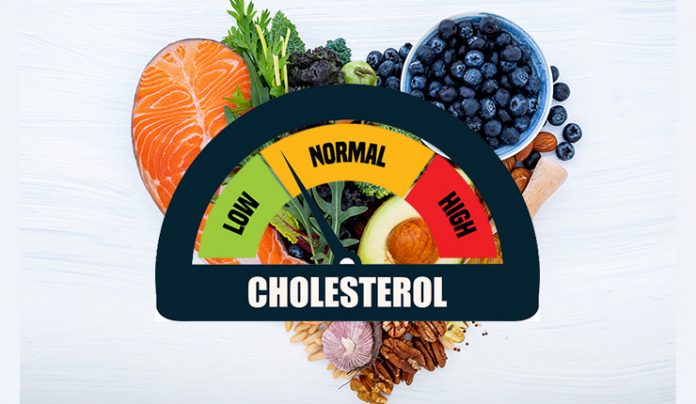
Cholesterol is a waxy, fat-like substance that is found in all the cells in our body. Cholesterol plays a vital role in our ability to build healthy cells and our body simply can’t function without it. It is made in the liver and has many important health functions, such as keeping the walls of cells flexible and assisting in the manufacture of hormones. But we need to understand that not all cholesterol is the same. Too much cholesterol in the blood can lead to clogged arteries, strokes, heart attacks, and kidney failure.
There are two types of cholesterols in our body-LDL (low-density lipoprotein) or bad cholesterol and HDL (high-density lipoprotein) or good cholesterol. A blood test called lipoprotein panel can measure your cholesterol levels.
LDL is the main source of cholesterol buildup that can make plaque in your arteries, putting you at risk for hardened arteries (atherosclerosis), heart disease, vascular issues and much more. On the other hand, HDL helps remove that bad cholesterol from your arteries.
If you have high cholesterol levels, it usually means you have too much LDL and not enough HDL. High cholesterol levels affect around one in every three Americans. But there are changes you can make today to help lower your LDL and increase your HDL.
If your cholesterol is creeping upward, your diet and exercise—the traditional cornerstones of heart health—could help to bring it down. A major analysis of several controlled trials involving hundreds of men and women found that dietary changes reduced LDL and total cholesterol while exercise alone had no effect on either. (However, adding aerobic exercise did enhance the lipid-lowering effects of a heart-healthy diet.)
The people in the studies followed a variety of diets, from Mediterranean to low-fat to low-calorie. However, the most effective diets substituted foods with the power to lower cholesterol for those that boost cholesterol. According to Kathy McManus, director of the Department of Nutrition at Brigham and Women’s Hospital, eating with your LDL in mind doesn’t have to be an exercise in self-deprivation. While you may have to say goodbye to a few snacks and fast foods, you can replace them with others that are equally satisfying. “You don’t have to follow an all-or-nothing approach. It’s really a matter of common sense,” she says. She suggests a few ways to start getting your cholesterol under control and keep it normal.
Dr. Elizabeth Klodas M.D., a leading cardiologist who trained at both the Mayo Clinic and Johns Hopkins, has successfully helped hundreds of patients achieve optimal cholesterol and blood pressure levels with dietary changes alone.
In fact, she’s managed to lower artery-clogging LDL levels by as much as 40 percent — a convincing argument to choosing food over expensive and often problematic statin drugs. She believes heart disease is preventable by making positive lifestyle changes.
“There are pockets of people around the world who live into their 100s and it’s not that they are on the perfect combination of drugs or any drugs at all,” she says. “The major difference is nutrition, the vast majority of high cholesterol is due to lifestyle factors, especially the foods we eat.”
Here are a few tips to lower your cholesterol naturally:
Avoid saturated fats, trans-fats, and dietary cholesterol

Saturated fats and dietary cholesterol, which are derived primarily from animal products, aren’t exactly heart-healthy. Foods with a lot of saturated fat include butter, fatty flesh like red meat, full-fat and low-fat dairy products, palm oil, and coconut oil. Top sources of dietary cholesterol include egg yolks, organ meats and shellfish.
Limit your intake of meat, poultry, and fish to no more than 3.5 to 4 ounces per day.
Eat only fats that are liquid at room temperature

Foods like olive oil, canola oil, and the oils in nuts and seeds are good examples. Oil in avocados and fish are beneficial. Plant and fish-based oils are a good sources of omega-3 fatty acids. These help lower LDL, raise HDL, also called the ‘good’ cholesterol, and lower triglycerides. They are also anti-inflammatory.
Eat a whole-food, plant-based diet

Foods naturally rich in soluble fiber have proven particularly good at lowering cholesterol. The fiber and plant sterols only found in plants work wonders on cholesterol levels by affecting how cholesterol is more efficiently circulated through the digestive tract. Because we cannot digest fiber, it traps cholesterol-rich bile and excretes it so that it doesn’t get reabsorbed in the body.
Excellent sources include oats, oat bran, barley, peas, yams, sweet potatoes and other potatoes, as well as legumes or beans, such as pinto beans, black beans, garbanzo beans, and peas. Vegetables rich in soluble fiber include carrots, Brussels sprouts, beets, okra, and eggplant. Good fruit sources are berries, passion fruit, oranges, pears, apricots, nectarines, and apples.
Legumes help lower LDL cholesterol, non-HDL cholesterol, blood sugar, and insulin levels, and may even lower cancer risk.
Nuts and seeds have been proven to modestly lower LDL cholesterol levels. To avoid blood-pressure-raising salt, choose raw or dry-roasted, unsalted varieties.
Avoid simple or processed carbohydrates

These foods increase your LDL cholesterol levels and cause HDL levels to plummet and raise triglyceride levels. Foods such as bagels, many breakfast cereals, and white rice, among others, are broken down into sugar and absorbed into the body quickly, causing insulin spikes. Insulin is a vital hormone designed to put sugar away but it also puts our bodies into a general storage mode, so the body not only stores sugar but LDL.
Exercise and lose as much excess weight as possible

Aerobic exercises like walking, running, biking, and swimming, coupled with resistance training will keep you and your heart healthy. This combination helps lower LDL levels and boosts the level of HDL.
Losing excess weight is beneficial for all sorts of reasons, from improving your cholesterol profile to preventing diseases like high blood pressure, type 2 diabetes, heart attacks, strokes and many types of cancer.
The above methods are medication-free alternatives for a healthy life.





